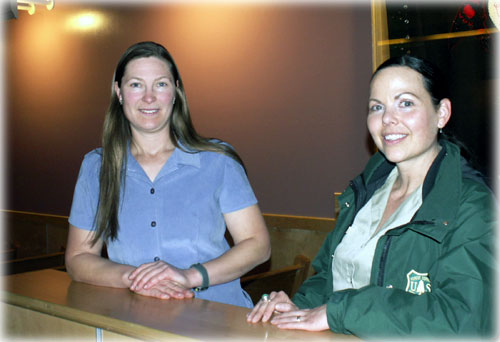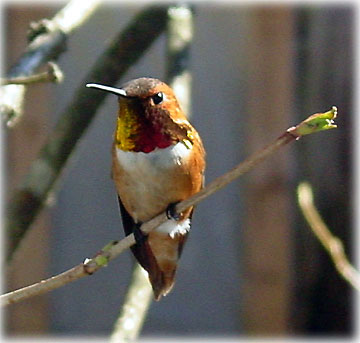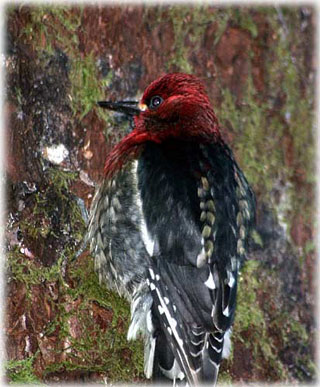 By Marie L. Monyak April 19, 2006
 and Leslie Swada Education Specialist. Photo by Marie L. Monyak
Speaking about hummingbirds, Baluss described how they winter in Mexico and the southwest and return to Alaska by way of the coastline taking advantage of the early spring blooming flowers. Once here, they breed during the summer and return south by a different route. "They stick to the high mountain ranges, the Cascades and Rockies, all the way down to the southwest taking full advantage of the late-summer blooms." Baluss presented her next slide that brought about a few gasps from the audience who thought the bird on display was dead. Viewing a tiny hummingbird lying on its side on a scale, Baluss relieved the audience when she stated, "The thing about hummingbirds is that they don't want to waste energy on anything [unnecessary] until they know for sure that they're free and even then we have to kind-of bump them into the air and then they go zipping off. It's pretty startling; they usually zip right by your head!" The next few slides showed thrushes and Baluss stated that most birders know how to identify each subspecies by the face patterns. She then proudly stated that there was a Veery thrush that by way of recorded data was said to be over 7 years old and was considered a world record. Next on the screen was a Lincoln sparrow that had been banded near Medford Oregon and was recovered at the Hoonah station. It was determined that the bird flew approximately 60 miles a day. "That's amazing, Lincoln sparrows have really short wings so it's not like they were gliding like an albatross or condor. That was powered flight the whole way," Baluss exclaimed. Sparrows were next in the slide show; Fox sparrow, Gold Crowned sparrow and Song sparrow. Baluss related the story of a woman that reported a banded Fox sparrow that had gone from Yakatat to Victoria B.C. Baluss said that unfortunately the bird had hit the woman's window and died. "To get a recovery, usually a bird has to die, someone will find a banded bird on the road and call it in. Sometimes a bander will capture one and call it in." Quickly, Baluss changed the subject to something more pleasant that caused the audience to laugh when she flatly stated, "Red cross-bills are weird!" Explaining her opinion she said, "We think of migratory birds as; this north-south, very programmed, get there by a certain date kind of thing." "The cross-bill is what we call eruptive, it plays by different rules, it just moves around." The cross-bills are seed eaters so they tend to disperse throughout their range wherever cones can be found. Baluss provided a close up photo of a cross-bill that clearly showed the upper bill crossing over the lower bill which enables the bird to pick seeds from the cones. Showing the photo of a Waxy Wing cross-bill taken by Baluss in Oaxaca Mexico, she said, "The people in Mexico told me that some years they have hundreds or thousands of them and other years they have none so we don't know where they're coming from or what sets them off." Moving on to other migrants, the next slide was of a Red Breasted sapsucker which Baluss said really do suck sap. (Try saying that real fast, even Baluss had trouble saying it, to the delight of the audience!)
Baluss explained how ecologically important the sap suckers are when she described them as "The earliest spring migrants that make the sap wells that hummingbirds and warblers use. They also make cavities which smaller birds like Nuthatches and Tree swallows can't make for themselves." The Ruby Crowned kinglet was next on the screen. Baluss related, "They're a very abundant little bird, not much larger than a hummingbird. The subspecies we have here in Alaska has an average nest clutch-size of 10, although they don't all make it, it's still pretty remarkable!" With a great deal of passion, Baluss spoke about warblers and said she can't talk about them without mentioning their habitat. Showing the photo of a mist net she had strung through a coffee plantation in Mexico, Baluss said with conviction, "Coffee is an important part of the habitat down there. I don't want to preach but shade grown coffee is a great product to buy if you drink coffee. This is an agricultural practice where growers retain some of the overstory layer in the forest and grow the coffee under it, it's a great bird habitat." There were plenty more slides of the colorfully feathered songbirds; the Townsend warbler that loves conifers in high mountain ranges, the Yellow warbler that Baluss said is the most beautiful species in our area, the Myrtle warbler also known as the Yellow Rumped warbler and the Orange Crowned warbler that should be showing up in our area sometime soon. "The American Red Star warbler is really considered more of an east coast bird," Baluss explained. "They've increased their range by following the boreal forest across our continent. They mostly come up the east coast and then go all the way across Canada, it's a really long range which explains why they arrive so late. I've never heard them singing until the 10th of June so they're real late-comers." Wrapping up her presentation, Baluss described several other banding techniques and tracking systems. Most interesting was the satellite telemetry project. Baluss said, "They actually put little satellite transmitters on the bird that beams a signal up to a satellite and they can be tracked that way. It's kind of like getting an email from your bird and seeing where he is!" Baluss ended her slide show with the photo of a bird that had been placed upside down in a cup and set on a scale. She explained that it's the easiest and safest way to get the weight of the bird when collecting data. Leave it to this inexperienced writer to pose the question, "Do you mean they just stay in the cup and won't try to get away?" To which Baluss responded, "No, birds don't fly backwards!" The Friday Night Insight Program scheduled for April 21st at 7:00 P.M. will be "Invasive Plants in Ketchikan Nip them in the Bud!" Pam Fletcher, Invasive Species Coordinator for the Tongass National Forest will use slides and pressed plants to assist her in discussing the invasive species found in Ketchikan. A freelance writer is an uncommitted independent writer who produces and sells articles to a publisher such as SitNews. For freelance writing services and costs contact Marie at mlmx1[at]hotmail.com Publish A Letter on SitNews Read Letters/Opinions
|
|||

